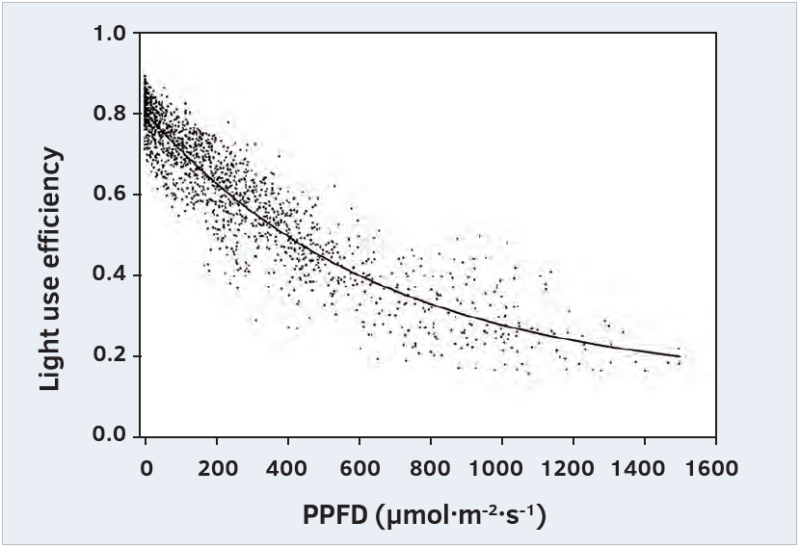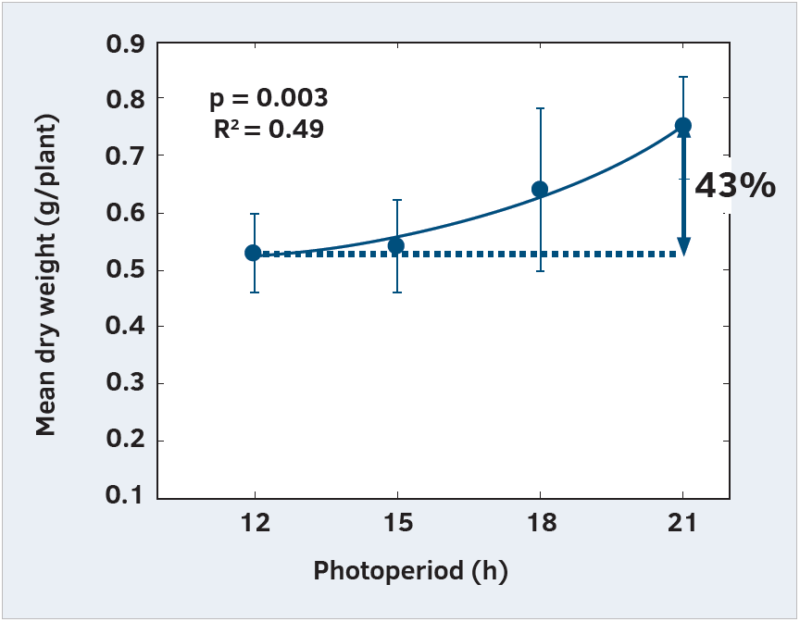Not All DLIs Are the Same
Sunlight gets scarce during the winter season. However, many plants are grown in winter for sale during the busy spring season. Electric lights, either HPS or LEDs, may be needed to supplement the light that plants get naturally to ensure on-time production of high-quality plants. Light requirements of horticultural crops are typically expressed based on the daily light integral (DLI, total amount of light received in a day).
The DLI provides a target for how much supplemental light needs to be provided, but this supplemental light comes with significant electricity costs, increasing production expenses. Research at the University of Georgia found that not all DLIs are the same: greenhouse crops grow faster with lower photosynthetic photon flux density (PPFD, the amount of photosynthetic light reaching the plant) and longer photoperiods. This can result in significant lower costs and higher revenues.
HOW THIS WORKS
We all know that plants need light for photosynthesis. But not all the light that reaches the plant is used for photosynthesis. When plants receive more light, they use it less efficiently. Since not all species have the same light use efficiency, they do not all benefit from supplemental light the same way.
But what is light use efficiency? Imagine a kitchen sink. When you turn the water on slowly, some water comes out of the faucet and most of it is drained rapidly. With a low water flow, the sink is not going to fill up. When you start increasing the water flow, the sink may no longer be able to drain all the water and the sink may start filling up. Now imagine that you start pouring buckets of water into the sink at once. The sink will fill, and the water will spill over the sides. With too much water coming in, the sink will exceed its capacity to drain the water.
Something similar happens with light and plants. Light is absorbed by chlorophyll and other pigments in the leaf which creates electrical currents, which in turn produce energy that is used to power photosynthesis. At a low PPFD, much of the light can be used to create electrical currents and power photosynthesis. Light is used efficiently, just like the sink can drain a slow water flow efficiently. However, when a plant receives more light, a smaller fraction of that light is used in photosynthesis; most of the excess light energy is converted into heat. Additionally, a small fraction of that light energy is converted into fluorescence. Plants that are exposed to light give off a faint glow in the red and far-red part of the spectrum, but not bright enough for us to see. The higher the PPFD, the more light energy will be converted into heat and less energy will be used for photosynthesis. Compare that to a sink that is unable to drain large amounts of water; at some point the plant cannot photosynthesize more, no matter how much extra light it receives. Inevitably, a plant’s light use efficiency decreases with increasing PPFD.
We can measure how much of the provided light is used to create the electrical currents that power photosynthesis by measuring changes in chlorophyll fluorescence. In other words, by measuring fluorescence we can quantify the plant’s light use efficiency when exposed to different PPFDs. Understanding how efficiently plants use the light they receive helps us to develop more cost-effective lighting strategies.

Because plants use light less efficiently as the PPFD increases (Figure 1), providing supplemental lighting when sunlight levels are high is an inefficient use of energy and money. On the other hand, supplemental light is most beneficial when sunlight levels are low, because the plants’ light use efficiency is higher: supplemental light will be utilized more efficiently to power photosynthesis and increase plant growth.
But the decrease in light use efficiency with increasing PPFD also suggests another way to increase the cost effectiveness of supplemental lighting. We hypothesized that by providing lower PPFDs, over longer photoperiods to achieve the same DLI, plants would be more light-use efficient and grow faster. On the other hand, when plants are provided a high PPFD over shorter photoperiods, their light use efficiency will decrease. We tested those hypotheses in greenhouse and controlled environment conditions on ornamentals and leafy greens.
WHAT WE DID
‘Little Gem’ lettuce plants were grown in a greenhouse with a DLI of 17 mol/m2/day (all plants received the same amount of light) spread over photoperiods ranging from 12 to 21. We also grew rudbeckia (black-eyed susan) seedlings at a DLI of 12 mol/m2/day, also with photoperiods ranging from 12 to 21 hours. Using a dimmable LED lighting system, we guaranteed that all plants received the same DLI. We will provide more details on how this can be achieved in an article in the September issue.
In a controlled environment growth chamber, we grew mizuna and ‘Little Gem’ lettuce at DLI of 16 mol/m2/day under photoperiods ranging from 10 to 20 hours. Here, all light was provided using dimmable LED light bars.
In all cases, plants under longer photoperiods were exposed to lower PPFDs to ensure that all plants were exposed to the same amount of light. Since plants can use the light more efficiently when the PPFD is low, we expected that long days with low PPFD would result in more growth than short days with high PPFD.
WHAT WE FOUND
‘Little Gem’ lettuce in the greenhouse grew much faster under longer photoperiods and lower PPFD compared to shorter photoperiods and high PPFD (Figure 2). In the case of mizuna and lettuce in the growth chamber with sole source lighting similar we found that their growth increased 19% and 16%, respectively, when the photoperiod was lengthened from 10 to 20 hours. One potential drawback of faster growth is that it may increase the risk of tipburn in lettuce.

In the case of rudbeckia in the greenhouse, we found that plants under the longest photoperiod (21 hours per day) and lower PPFD were approximately 30% larger than those under the shortest photoperiod (12 hours) and higher PPFD, even when all plant received the same amount of light (Figure 3). However, there were no differences on plant quality measurements such as root fraction and compactness. Based on our results, prolonging the photoperiod can reduce the crop cycle of rudbeckia seedling by at least one week, increasing the turnover rate.
Since longer photoperiods can be combined with a lower PPFD, the maximum PPFD that needs to be provided by the supplemental lighting is reduced. That means that fewer fixtures are needed, reducing in the capital expense.

DOES THIS WORK FOR ALL SPECIES?
Increasing the photoperiod can affect flowering of both short- and long-day plants. Short-day plants may not flower under longer photoperiods, while long-day plants will flower sooner. That faster flowering may or may not be desired. For example, in the plug stage, flowering is not desired, since it diverts energy away from growth. When deciding what photoperiod to use for supplemental lighting, the impact on flowering needs to be considered.
TAKE-HOME MESSAGES
When supplemental light is used, it should be provided when sunlight levels are low. That will allow plants to use the supplemental light as efficiently as possible. In addition, longer photoperiods produced by supplemental lighting can increase plant growth. But first be sure this is not going to inadvertently affect flowering. Before implementing a new lighting strategy, we recommend that you test it first on a small number of plants under your own growing conditions.









 Video Library
Video Library 


















